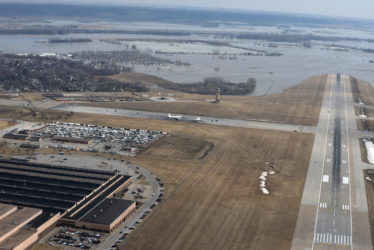
US Military Construction Standards Require Climate Security Update
Over the last decade, the US has witnessed some of the most damaging storms ever recorded. These storms cause billions in damage and are a threat to US national security. As the climate continues to change, storms are predicted to intensify. To prepare for stronger storms, the Department of Defense (DoD) is updating its construction standards for military installations.
In May 2019, ASP President, Brigadier General Stephen Cheney, USMC (Ret.) toured Camp Lejeune in the aftermath of Hurricane Florence. Months after the storm, he witnessed tarps still covering rooftops and the on-going repairs to a large percent of the buildings. Hurricane Florence is estimated to have caused $3.6 billion in damage to North Carolina military infrastructure. US Marine Corps Gen. Robert Neller was forced to curtail or cancel several training exercises to free up funds for hurricane repair.
Severe flooding at Offutt Air Force Base, in May 2019, caused extensive damage. In October 2018, Hurricane Michael hit Tyndall Air Force Base. Experts predict it will take years to rebuild both bases and cost billions of taxpayer dollars. In part due to the damage at Tyndall and Offutt Air Force Bases, the Air Force requested supplemental funding for this year, and an additional $3.7 billion for fiscal years 2020 and 2021. Without the additional funding, the Air Force may need to forego regularly scheduled facility maintenance, ground combat aircraft, and cut flying time for non-deploying squadrons. Such cuts will affect military readiness and put U.S. national security at risk.
The Government Accountability Office (GAO) released a report in June 2019 calling for DoD to assess risk and provide guidance on climate projections in installation master plans and facilities designs. In its report, GAO made many recommendations, including that the Secretary of Defense issue guidance on incorporating climate projections into facilities project designs; the DoD concurred with GAO’s recommendation, and all the others.
In October 2019, Robert H. McMahon, assistant secretary of defense for sustainment, testified before a joint hearing of the House Armed Services subcommittees on readiness and emerging threats and capabilities. In his testimony, he said,
“We take the lessons we learn from each of these installations — whether it is the construction, whether it’s the roofing, what we are doing on one floor versus another — and roll that in on an annual basis to continuously update what those standards are to ensure that, as we get to the next either rehab or new construction, that those standards are, in fact, reflected in the way that we build the facility.”
Additionally, McMahon explained,
“As we look out over the last decade or two decades, the challenges and threats we face within our installations have grown dramatically.”
“It’s climate. It’s the challenge we also face with regards to natural disasters, whether that be earthquakes, whether that be forest fires, whether that be deforestation or drought,” he added.
McMahon argued DoD must acknowledge that the climate is changing, and military installations must be resilient and ready.
“We look at the way that we proactively put together our standards, our building standards, they need to be continuously updated as we learn about what is occurring with these natural disasters,” he said.
While DoD is proactively updating its construction standards, Congress has proposed codifying this procedure to take into account future threats, like climate change. Section 2805 of H.R. 2500, the National Defense Authorization Act (NDAA) for Fiscal Year 2020, directs the Secretary of Defense to:
“amend the Unified Facility Criteria related to military construction planning and design to ensure that building practices and standards promote military installation resilience, energy resilience, energy and climate resiliency, and cyber resilience.”
In doing so, the legislation directs the Secretary of Defense to consider historical data, current conditions, and sea level rise projections. Additionally, the Secretary is required to conduct a review of military installation building standards, beginning in 2022, and annually thereafter, to ensure that military construction is keeping up with resilience standards.
The Senate has included similar language in its version of the NDAA (S. 1790). The House and Senate are currently working to resolve issues pertaining to other provisions of the legislation.
DoD’s proactive approach to ensuring military installations are resilient in the face of future threats is good, and the language included in the NDAA to codify that is a step in the right direction. The US’ ability to project power abroad requires military installations at home and around the globe to be resilient and ready when disaster strikes. The military cannot afford to be crippled by damaged infrastructure or the inability to train. ASP launched a new website in September that examines climate threats—sea level rise, extreme storms, extreme heat and drought, and Arctic ice melt—their impact on military installations and makes recommendations on how best to prepare. DoD’s new construction standards are a step in the right direction.





